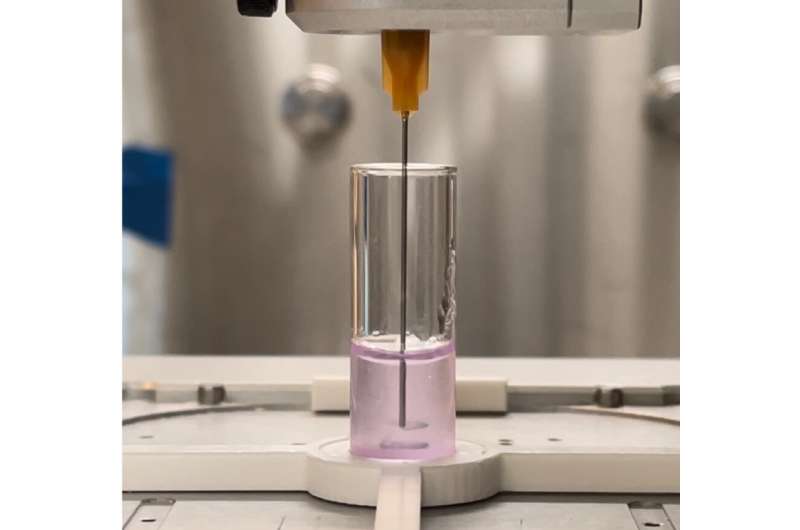This article has been reviewed according to Science X's editorial process and policies. Editors have highlighted the following attributes while ensuring the content's credibility:
fact-checked
peer-reviewed publication
trusted source
proofread
Granulated gels: The best of both worlds for bioprinted cells

Printing living cells into functional tissues is highly complex, and with every technological innovation more challenges are presented.
The Levato lab of UMC Utrecht has, together with colleagues, successfully managed to merge two promising printing techniques in order to increase both cell density, cell survival and specialization in bioprints. The key: granular biogels or resins.
Their work is published in the journal Advanced Materials.
Cells are high-maintenance
Printing living cells, called bioprinting, is a promising technique for the creation of functional tissues made from stem cells. However, marrying this intricate technology with sensitive cells is a huge challenge. If you want to bioprint cells, they need to be pampered in order to survive and thrive in the finished product. And if they are to form a functional tissue, they need to be able to grow, move, and communicate with each other.
Various printing strategies have been tried to solve this, and they all have their pros and cons. In 3D extrusion printing, cells can be deposited in a variety of types and with high numbers, but this process takes very long, causes mechanical stress to the cells and is gravity-dependent—all detrimental to the cells' survival and functioning.
With fast volumetric bioprinting, speed and gravity have been solved, but here the challenge is that cells are distributed randomly in the resin and in lower numbers, and because the final print consists of solid resin, the cells are unable to function and communicate properly.
Creating a granular microworld
To solve this issue, the materials used for bioprinting must provide an environment that allows for the self-organization and communication of cells. While this is generally possible with soft hydrogels, ensuring high printing resolution and shape fidelity of these materials remains a key bottleneck, especially when using conventional layer-by-layer fabrication techniques.
First author Davide Ribezzi explored the use of granular resins to overcome these challenges. "Granular gels are basically gel microparticles packed tightly together," Ribezzi says. "While each microparticle possesses comparable properties to its bulk hydrogel counterpart, packed microgel particles can be designed and customized to display a broad array of added useful properties."
Leveraging on particulate biomaterials is therefore a promising strategy to face drawbacks related to bulk cell encapsulation and material processability in the printing processes.

Combining different printing strategies
The granulated resins indeed allowed the researchers to combine extrusion and volumetric printing. Using extrusion printing, certain cells or other chemicals can be specifically deposited in the resin. This approach optimizes the balance between the speed of volumetric printing with the accuracy of extrusion printing.
The gel moves around the printing nozzle like custard around an intrusive finger, so the cells can be placed in multiple layers quickly, without having to worry about the strength of the structure. Then, volumetric printing can finish the process by creating and finessing the shapes around the extruded cells.
This process wasn't without its challenges. Ribezzi says, "Processing biological materials always requires lots of attention and meticulous planning of the experiments. But in our research we exploit the thermal properties of the microgel, which allows for a precise tuning of the mechanical and optical properties. This translated into tunable stimuli sensed by the embedded cells. However, this higher degree of tuning needed an even higher degree of attention and precision during the printing process."
More biological activity: The proof is in the granular pudding
Experiments with cells confirm that the granulated resins allow for much more biological activity after printing, vastly outperforming the solid gels. Within eight days of being printed into the resin, stem cells were able to spread out more, epithelial cells created more junctions and neuron-like cells made more connections to each other.
Ribezzi says, "For future studies, we envision the mixing and even local patterning of microgels obtained from different materials. It would allow us to create composite constructs with unique properties, or with bioactive pockets releasing for example drugs. These tools will boost tissue functionality, open up additional opportunities for tissue engineering, regenerative medicine, and the emerging area of engineered living materials."
More information: Davide Ribezzi et al, Shaping Synthetic Multicellular and Complex Multimaterial Tissues via Embedded Extrusion‐Volumetric Printing of Microgels, Advanced Materials (2023). DOI: 10.1002/adma.202301673
Journal information: Advanced Materials
Provided by University Medical Center Utrecht

















